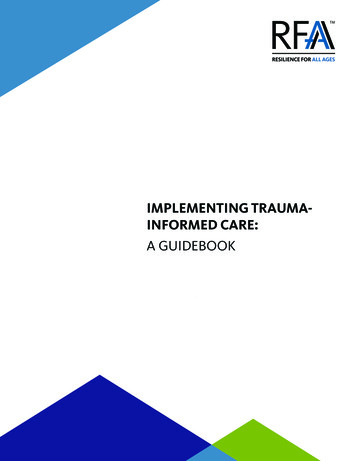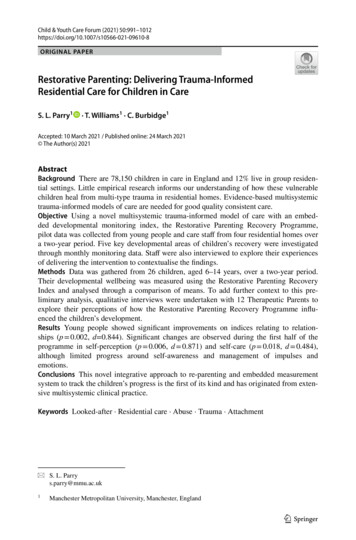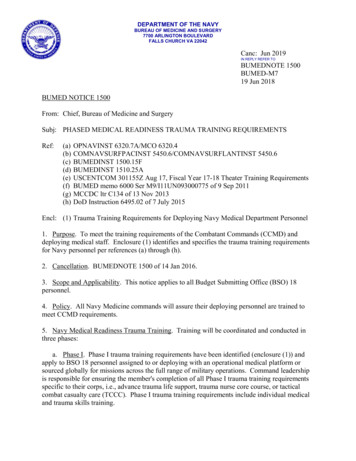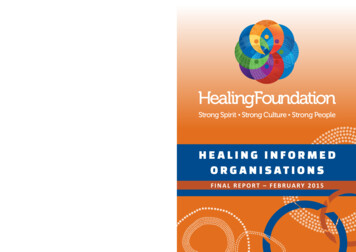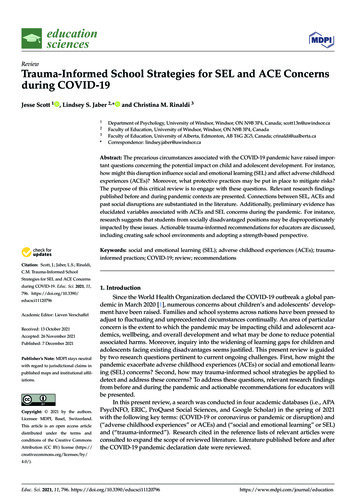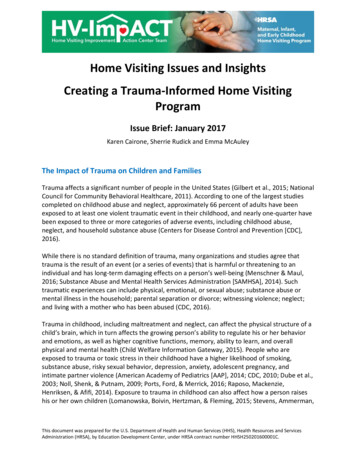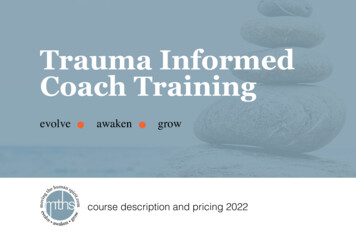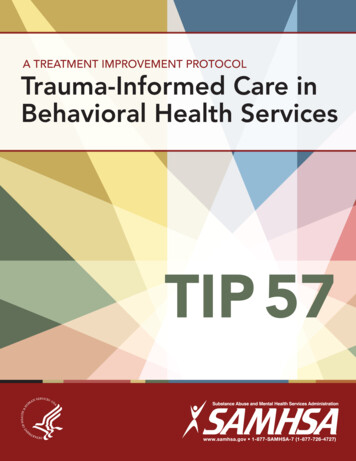
Transcription
A TREATMENT IMPROVEMENT PROTOCOLTrauma-Informed Care inBehavioral Health ServicesTIP 57
A TREATMENT IMPROVEMENT PROTOCOLTrauma-Informed Care inBehavioral Health ServicesTIP 57U.S. DEPARTMENT OF HEALTH AND HUMAN SERVICESSubstance Abuse and Mental Health Services AdministrationCenter for Substance Abuse Treatment1 Choke Cherry RoadRockville, MD 20857
Trauma-Informed Care in Behavioral Health ServicesAcknowledgmentsThis publication was produced under contract numbers 270-99-7072, 270-04-7049, and 270 09-0307 by the Knowledge Application Program (KAP), a Joint Venture of The CDM Group,Inc., and JBS International, Inc., for the Substance Abuse and Mental Health ServicesAdministration (SAMHSA), U.S. Department of Health and Human Services (HHS). AndreaKopstein, Ph.D., M.P.H., Karl D. White, Ed.D., and Christina Currier served as theContracting Officer’s Representatives.DisclaimerThe views, opinions, and content expressed herein are the views of the consensus panel membersand do not necessarily reflect the official position of SAMHSA or HHS. No official support ofor endorsement by SAMHSA or HHS for these opinions or for the instruments or resourcesdescribed are intended or should be inferred. The guidelines presented should not be consideredsubstitutes for individualized client care and treatment decisions.Public Domain NoticeAll materials appearing in this volume except those taken directly from copyrighted sources arein the public domain and may be reproduced or copied without permission from SAMHSA orthe authors. Citation of the source is appreciated. However, this publication may not bereproduced or distributed for a fee without the specific, written authorization of the Office ofCommunications, SAMHSA, HHS.Electronic Access and Copies of PublicationThis publication may be ordered or downloaded from SAMHSA’s Publications Ordering Webpage at http://store.samhsa.gov. Or, please call SAMHSA at 1-877-SAMHSA-7 (1-877-726 4727) (English and Español).Recommended CitationSubstance Abuse and Mental Health Services Administration. Trauma-Informed Care inBehavioral Health Services. Treatment Improvement Protocol (TIP) Series 57. HHS PublicationNo. (SMA) 13-4801. Rockville, MD: Substance Abuse and Mental Health ServicesAdministration, 2014.Originating OfficeQuality Improvement and Workforce Development Branch, Division of Services Improvement,Center for Substance Abuse Treatment, Substance Abuse and Mental Health ServicesAdministration, 1 Choke Cherry Road, Rockville, MD 20857.HHS Publication No. (SMA) 14-4816First Printed 2014ii
Please share your thoughts about this publication by completing a brief online survey at:https://www.surveymonkey.com/r/KAPPFSThe survey takes about 7 minutes to complete and is anonymous.Your feedback will help SAMHSA develop future products.
ContentsConsensus Panel. viiKAP Expert Panel and Federal Government Participants .ixWhat Is a TIP? .xiForeword. xiiiHow This TIP Is Organized . xvTerminology .xviPART 1: A PRACTICAL GUIDE FOR THE PROVISION OF BEHAVIORALHEALTH SERVICES . 1Chapter 1—Trauma-Informed Care: A Sociocultural Perspective . 3Scope of the TIP . 4Intended Audience. 4Before You Begin . 4Structure of the TIP. 6What Is Trauma?. 7Trauma Matters in Behavioral Health Services. 7Trauma-Informed Intervention and Treatment Principles. 11As You Proceed . 32Chapter 2—Trauma Awareness .33Types of Trauma. 33Characteristics of Trauma . 46Individual and Sociocultural Features. 52Chapter 3—Understanding the Impact of Trauma .59Sequence of Trauma Reactions . 60Common Experiences and Responses to Trauma. 61Subthreshold Trauma-Related Symptoms . 75Specific Trauma-Related Psychological Disorders. 77Other Trauma-Related and Co-Occurring Disorders . 85iii
Trauma-Informed Care in Behavioral Health ServicesChapter 4—Screening and Assessment .91Screening and Assessment . 92Barriers and Challenges to Trauma-Informed Screening and Assessment . 99Cross-Cultural Screening and Assessment. 103Choosing Instruments. 104Trauma-Informed Screening and Assessment. 106Concluding Note. 110Chapter 5—Clinical Issues Across Services.111Trauma-Informed Prevention and Treatment Objectives . 111Treatment Issues . 127Making Referrals to Trauma-Specific Services. 135Chapter 6—Trauma-Specific Services .137Introduction . 137Trauma-Specific Treatment Models . 139Integrated Models for Trauma. 147Emerging Interventions . 153Concluding Note. 155PART 2: AN IMPLEMENTATION GUIDE FOR BEHAVIORAL HEALTHPROGRAM ADMINISTRATORS.157Chapter 1—Trauma-Informed Organizations .159Strategy #1: Show Organizational and Administrative Commitment to TIC. 161Strategy #2: Use Trauma-Informed Principles in Strategic Planning . 162Strategy #3: Review and Update Vision, Mission, and Value Statements. 162Strategy #4: Assign a Key Staff Member To Facilitate Change . 163Strategy #5: Create a Trauma-Informed Oversight Committee . 163Strategy #6: Conduct an Organizational Self-Assessment of Trauma-Informed Services . 164Strategy #7: Develop an Implementation Plan. 164Strategy #8: Develop Policies and Procedures To Ensure Trauma-Informed Practices andTo Prevent Retraumatization . 166Strategy #9: Develop a Disaster Plan. 166Strategy #10: Incorporate Universal Routine Screenings . 167Strategy #11: Apply Culturally Responsive Principles . 167Strategy #12: Use Science-Based Knowledge. 169Strategy #13: Create a Peer-Support Environment. 169Strategy #14: Obtain Ongoing Feedback and Evaluations . 170Strategy #15: Change the Environment To Increase Safety. 171Strategy #16: Develop Trauma-Informed Collaborations . 171Chapter 2—Building a Trauma-Informed Workforce .173Introduction . 173Workforce Recruitment, Hiring, and Retention. 174iv
ContentsTraining in TIC . 177Trauma-Informed Counselor Competencies . 181Counselor Responsibilities and Ethics. 182Clinical Supervision and Consultation . 191Secondary Traumatization . 193Counselor Self-Care. 205APPENDICES.215Appendix A—Bibliography .215Appendix B—Trauma Resource List.247Appendix C—Historical Account of Trauma.267Appendix D—Screening and Assessment Instruments .271Appendix E—Consumer Materials.285Appendix F—Organizational Assessment for Trauma-Informed Care.287Appendix G—Resource Panel .289Appendix H—Field Reviewers .293Appendix I—Cultural Competence and Diversity Network Participants .299Appendix J—Acknowledgments .300EXHIBITSExhibit 1.1-1: TIC Framework in Behavioral Health Services—Sociocultural Perspective . 6Exhibit 1.1-2: A Social-Ecological Model for Understanding Trauma and Its Effects . 15Exhibit 1.1-3: Understanding the Levels Within the Social-Ecological Model ofTrauma and Its Effects. 16Exhibit 1.1-4: Cross-Cutting Factors of Culture. 26Exhibit 1.2-1: Trauma Examples . 35Exhibit 1.3-1: Immediate and Delayed Reactions to Trauma . 62Exhibit 1.3-2: Cognitive Triad of Traumatic Stress . 67Exhibit 1.3-3: DSM-5 Diagnostic Criteria for ASD . 78Exhibit 1.3-4: DSM-5 Diagnostic Criteria for PTSD. 82Exhibit 1.3-5: ICD-10 Diagnostic Criteria for PTSD . 85Exhibit 1.3-6: Important Treatment Facts About PTSD and Substance Use Disorders. 89Exhibit 1.4-1: Grounding Techniques . 98Exhibit 1.4-2: Key Areas of Trauma Screening and Assessment. 105Exhibit 1.4-3: SLE Screening. 107Exhibit 1.4-4: STaT: Intimate Partner Violence Screening Tool . 108Exhibit 1.4-5: PC-PTSD Screen. 108Exhibit 1.4-6: The SPAN . 108Exhibit 1.4-7: The PTSD Checklist. 109Exhibit 1.4-8: Resilience Scales . 110Exhibit 1.5-1: OBSERVATIONS: A Coping Strategy. 119v
Trauma-Informed Care in Behavioral Health ServicesExhibit 2.1-1: TIC Planning Guidelines . 165Exhibit 2.2-1: Clinical Practice Issues Relevant to Counselor Training in TraumaInformed Treatment Settings. 179Exhibit 2.2-2: Guidelines for Training in Mental Health Interventions for Trauma Exposed Populations. 180Exhibit 2.2-3: Trauma-Informed Counselor Competencies Checklist . 183Exhibit 2.2-4: Sample Statement of the Client’s Right to Confidentiality From aClient Bill of Rights. 185Exhibit 2.2-5: Green Cross Academy of Traumatology Ethical Guidelines for theTreatment of Clients Who Have Been Traumatized . 186Exhibit 2.2-6: Boundaries in Therapeutic Relationships. 189Exhibit 2.2-7: Counselor Strategies To Prevent Secondary Traumatization . 198Exhibit 2.2-8: Secondary Traumatization Signs . 199Exhibit 2.2-9: ProQOL Scale . 201Exhibit 2.2-10: Your Scores on the ProQOL: Professional Quality of Life Screening. 202Exhibit 2.2-11: What Is My Score and What Does It Mean?. 203Exhibit 2.2-12: Clinical Supervisor Guidelines for Addressing Secondary Traumatization. 205Exhibit 2.2-13: Comprehensive Self-Care Plan Worksheet. 208Exhibit 2.2-14: Comprehensive Self-Care Plan Worksheet Instructions. 209Exhibit 2.2-15: The Ethics of Self-Care. 210vi
Consensus PanelNote: Each panelist’s information reflects his or her affiliation at the time of the ConsensusPanel meeting and may not reflect that person’s most current affiliation.ChairLisa M. Najavits, Ph.D.Research PsychologistVeterans Affairs Boston Healthcare SystemProfessor of PsychiatryBoston University School of MedicineBoston, MACo-ChairLinda B. Cottler, Ph.D., M.P.H.Professor of Epidemiology in PsychiatryDepartment of PsychiatryWashington University–St. LouisSt. Louis, MOWorkgroup LeadersStephanie S. Covington, Ph.D., LCSW,MFCCCo-DirectorCenter for Gender and JusticeInstitute for Relational DevelopmentLa Jolla, CAMargaret Cramer, Ph.D.Clinical Psychologist/Clinical InstructorHarvard Medical SchoolBoston, MAAnne M. Herron, M.S.DirectorTreatment ProgrammingNew York State Office of Alcoholism andSubstance Abuse ServicesAlbany, NYDenise Hien, Ph.D.Research ScholarSocial Intervention GroupSchool of Social WorkColumbia UniversityNew York, NYDee S. Owens, M.P.A.DirectorAlcohol-Drug InformationIndiana UniversityBloomington, INPanelistsCharlotte Chapman, M.S., LPC, CACTraining DirectorDivision of Addiction PsychiatryMid-Atlantic Addiction Technology TransferCenterVirginia Commonwealth UniversityRichmond, VAvii
Trauma-Informed Care in Behavioral Health ServicesScott F. Coffey, Ph.D.Associate ProfessorDepartment of Psychiatry and HumanBehaviorUniversity of Mississippi Medical CenterJackson, MSRenee M. Cunningham-Williams, M.S.W.,M.P.E., Ph.D.Research Assistant/Professor of Social WorkDepartment of PsychiatryWashington UniversitySt. Louis, MOChad D. Emrick, Ph.D.Administrative DirectorSubstance Abuse Treatment ProgramDenver VA Medical Center (116A1)Denver, COCharles R. Figley, Ph.D.ProfessorDirector of the Traumatology InstituteFlorida State UniversityTallahassee, FLLarry M. Gentilello, M.D., FACSProfessor and ChairmanDivision of Burn, Trauma, and Critical CareUniversity of Texas Southwestern MedicalSchoolDallas, TXviiiRobert Grant, Ph.D.Trauma ConsultantOakland, CAAnthony (Tony) Taiwai Ng, M.D.Disaster PsychiatristWashington, DCPallavi Nishith, Ph.D.Associate Research ProfessorCenter for TraumaDepartment of PsychologyUniversity of Missouri–St. LouisSt. Louis, MOJoseph B. Stone, Ph.D., CACIII, ICADCProgram Manager and Clinical SupervisorConfederated Tribes of Grand RondeBehavioral Health ProgramGrand Ronde, ORMichael Villanueva, Ph.D.Research ProfessorCenter on Alcoholism, Substance Abuse, andAddictionAlbuquerque, NM
.KAP Expert Panel and FederalGovernment ParticipantsBarry S. Brown, Ph.D.Adjunct ProfessorUniversity of North Carolina–WilmingtonCarolina Beach, NCCatherine E. Dube, Ed.D.Independent ConsultantBrown UniversityProvidence, RIJacqueline Butler, M.S.W., LISW, LPCC,CCDC III, CJSProfessor of Clinical PsychiatryCollege of MedicineUniversity of CincinnatiCincinnati, OHJerry P. Flanzer, D.S.W., LCSW, CACChief, ServicesDivision of Clinical and Services ResearchNational Institute on Drug AbuseBethesda, MDDeion CashExecutive DirectorCommunity Treatment and CorrectionCenter, Inc.Canton, OHDebra A. Claymore, M.Ed.Adm.Owner/Chief Executive OfficerWC Consulting, LLCLoveland, COCarlo C. DiClemente, Ph.D.ChairDepartment of PsychologyUniversity of Maryland–Baltimore CountyBaltimore, MDMichael Galer, D.B.A.Independent ConsultantWestminster, MARenata J. Henry, M.Ed.DirectorDivision of Alcoholism, Drug Abuse andMental HealthDelaware Department of Health and SocialServicesNew Castle, DEJoel Hochberg, M.A.PresidentAsher & PartnersLos Angeles, CAix
Trauma-Informed Care in Behavioral Health ServicesJack Hollis, Ph.D.Associate Director, Center for HealthResearchKaiser PermanentePortland, ORMary Beth Johnson, M.S.W.DirectorAddiction Technology Transfer CenterUniversity of Missouri–Kansas CityKansas City, MOEduardo LopezExecutive ProducerEVS CommunicationsWashington, DCHolly A. Massett, Ph.D.Academy for Educational DevelopmentWashington, DCDiane MillerChiefScientific Communications BranchNational Institute on Alcohol Abuse andAlcoholismBethesda, MDHarry B. Montoya, M.A.President/Chief Executive OfficerHands Across CulturesEspañola, NMRichard K. Ries, M.D.Director/ProfessorOutpatient Mental Health ServicesDual Disorder ProgramsSeattle, WAGloria M. Rodriguez, D.S.W.Research ScientistDivision of Addiction ServicesNew Jersey Department of Health andSenior ServicesTrenton, NJxEverett Rogers, Ph.D.Center for Communications ProgramsJohns Hopkins UniversityBaltimore, MDJean R. Slutsky, P.A., M.S.P.H.Senior Health Policy AnalystAgency for Healthcare Research & QualityRockville, MDNedra Klein Weinreich, M.S.PresidentWeinreich CommunicationsCanoga Park, CAClarissa WittenbergDirectorOffice of Communications and PublicLiaisonNational Institute of Mental HealthBethesda, MDConsulting Members of the KAPExpert PanelPaul Purnell, M.ASocial Solutions, LLCPotomac, MDScott Ratzan, M.D., M.P.A., M.A.Academy for Educational DevelopmentWashington, DCThomas W. Valente, Ph.D.DirectorMaster of Public Health ProgramDepartment of Preventive MedicineSchool of MedicineUniversity of Southern CaliforniaLos Angeles, CAPatricia A. Wright, Ed.D.Independent ConsultantBaltimore, MD
.What Is a TIP?Treatment Improvement Protocols (TIPs) are developed by the Substance Abuse and MentalHealth Services Administration (SAMHSA) within the U.S. Department of Health and HumanServices (HHS). Each TIP involves the development of topic-specific best practice guidelines forthe prevention and treatment of substance use and mental disorders. TIPs draw on the experienceand knowledge of clinical, research, and administrative experts of various forms of treatment andprevention. TIPs are distributed to facilities and individuals across the country. Published TIPscan be accessed via the Internet at http://store.samhsa.gov.Although each consensus-based TIP strives to include an evidence base for the practices it rec ommends, SAMHSA recognizes that behavioral health is continually evolving, and research fre quently lags behind the innovations pioneered in the field. A major goal of each TIP is to convey“front-line” information quickly but responsibly. If research supports a particular approach, cita tions are provided.xi
.ForewordThe Substance Abuse and Mental Health Services Administration (SAMHSA) is the agencywithin the U.S. Department of Health and Human Services that leads public health efforts toadvance the behavioral health of the nation. SAMHSA’s mission is to reduce the impact of sub stance abuse and mental illness on America’s communities.The Treatment Improvement Protocol (TIP) series fulfills SAMHSA’s mission to improve pre vention and treatment of substance use and mental disorders by providing best practices guidanceto clinicians, program administrators, and payers. TIPs are the result of careful consideration ofall relevant clinical and health services research findings, demonstration experience, and imple mentation requirements. A panel of non-Federal clinical researchers, clinicians, program admin istrators, and patient advocates debates and discusses their particular area of expertise until theyreach a consensus on best practices. This panel’s work is then reviewed and critiqued by fieldreviewers.The talent, dedication, and hard work that TIP panelists and reviewers bring to this highly par ticipatory process have helped bridge the gap between the promise of research and the needs ofpracticing clinicians and administrators to serve, in the most scientifically sound and effectiveways, people in need of behavioral health services. We are grateful to all who have joined with usto contribute to advances in the behavioral health field.Pamela S. Hyde, J.D.AdministratorSubstance Abuse and Mental Health Services AdministrationH. Westley Clark, M.D., J.D.,M.P.H., CAS, FASAMDirectorCenter for Substance AbuseTreatmentSubstance Abuse and MentalHealth Services AdministrationFrances M. HardingDirectorCenter for Substance AbusePreventionSubstance Abuse and MentalHealth Services AdministrationPaolo del Vecchio, M.S.W.DirectorCenter for Mental HealthServicesSubstance Abuse and MentalHealth Services Administrationxiii
How This TIP Is OrganizedThis Treatment Improvement Protocol (TIP) is divided into three parts: Part 1: A Practical Guide for the Provision of Behavioral Health Services Part 2: An Implementation Guide for Behavioral Health Program Administrators Part 3: A Review of the LiteraturePart 1 is for behavioral health service providers and consists of six chapters. Recurring themesinclude the variety of ways that substance abuse, mental health, and trauma interact; the im portance of context and culture in a person’s response to trauma; trauma-informed screening andassessment tools, techniques, strategies, and approaches that help behavioral health professionalsassist clients in recovery from mental and substance use disorders who have also been affected byacute or chronic traumas; and the significance of adhering to a strengths-based perspective thatacknowledges the resilience within individual clients, providers, and communities.Chapter 1 lays the groundwork and rationale for the implementation and provision of traumainformed services. It provides an overview of specific trauma-informed intervention and treat ment principles that guide clinicians, other behavioral health workers, and administrators inbecoming trauma informed and in creating a trauma-informed organization and workforce.Chapter 2 provides an overview of traumatic experiences. It covers types of trauma; distinguishesamong traumas that affect individuals, groups, and communities; describes trauma characteristics;and addresses the socioecological and cultural factors that influence the impact of trauma. Chap ter 3 broadly focuses on understanding the impact of trauma, trauma-related stress reactions andassociated symptoms, and common mental health and substance use disorders associated withtrauma. Chapter 4 provides an introduction to screening and assessment as they relate to traumaand is devoted to screening and assessment processes and tools that are useful in evaluatingtrauma exposure, its effects, and client intervention and treatment needs. Chapter 5 covers clini cal issues that counselors and other behavioral health professionals may need to know and ad dress when treating clients who have histories of trauma. Chapter 6 presents information onspecific treatment models for trauma, distinguishing integrated models (which address substanceuse disorders, mental disorders, and trauma simultaneously) from those that treat trauma alone.Advice to Counselors and/or Administrators boxes in Part 1 provide practical information forproviders. Case illustrations, exhibits, and text boxes further illustrate information in the text byoffering practical examples.Part 2 provides an overview of programmatic and administrative practices that will help behav ioral health program administrators increase the capacity of their organizations to deliverxv
Trauma-Informed Care in Behavioral Health Servicestrauma-informed services. Chapter 1 examines the essential ingredients, challenges, and processesin creating and implementing trauma-informed services within an organization. Chapter 2focuses on key development activities that support staff members, including trauma-informedtraining and supervision, ethics, and boundaries pertinent to responding to traumatic stress,secondary trauma, and counselor self-care.Advice to Administrators and/or Supervisors boxes in Part 2 highlight more detailed informationthat supports the organizational implementation of trauma-informed care (TIC). In addition,case illustrations, organizational activities, and text boxes reinforce the material presented withinthis section.Part 3 is a literature review on TIC and behavioral health services and is intended for use by clin ical supervisors, interested providers, and administrators. Part 3 has three sections: an analysis ofthe literature, links to select abstracts of the references most central to the topic, and a generalbibliography of the available literature. To facilitate ongoing updates (performed periodically forup to 3 years from first publication), the literature review is only available online at the SubstanceAbuse and Mental Health Services Administration (SAMHSA) Publications Ordering Webpage (http://store.samhsa.gov).TerminologyBehavioral health: Throughout the TIP, the term “behavioral health” is used. Behavioral healthrefers to a state of mental/emotional being and/or choices and actions that affect wellness. Be havioral health problems include substance abuse or misuse, alcohol and drug addiction, seriouspsychological distress, suicide,
Acknowledgments . This publication was produced under contract numbers 270-99-7072, 270-04-7049, and 270 09-0307 by the Knowledge Application Program (KAP), a Joint Venture of The CDM Group,

